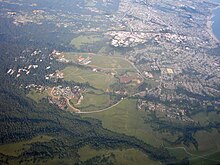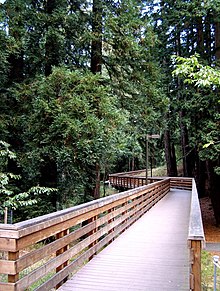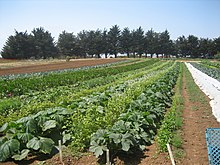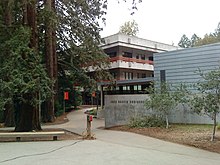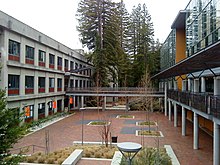University of California, Santa Cruz
 | |
| Motto | Fiat lux (Latin) |
|---|---|
Motto in English | Let there be light |
| Type | Public Land-grant Space-grant |
| Established | 1965[1] |
| Endowment | $190.1 million (2017)[2] |
| Chancellor | George Blumenthal |
| Provost | Marlene Tromp |
| Students | 19,700 (fall 2018)[3] |
| Undergraduates | 17,792 (fall 2018)[4] |
| Postgraduates | 1,908 (fall 2018)[5] |
| Location | Santa Cruz , California , U.S. |
| Campus | Suburban/forest 2,000 acres (810 ha)[6] |
| Academic term | Quarter |
| Colors | Blue and Gold[7] |
| Athletics | NCAA Division III – Independent |
| Nickname | Banana Slugs |
| Affiliations | University of California APLU |
| Mascot | Sammy the Slug[8] |
| Website | www.ucsc.edu |
 | |
The University of California, Santa Cruz (also known as UC Santa Cruz or UCSC) is a public research university in Santa Cruz, California. It is one of 10 campuses in the University of California system. Located 75 miles (120 km) south of San Francisco at the edge of the coastal community of Santa Cruz, the campus lies on 2,001 acres (810 ha) of rolling, forested hills overlooking the Pacific Ocean and Monterey Bay.
Founded in 1965, UC Santa Cruz began as a showcase for progressive, cross-disciplinary undergraduate education, innovative teaching methods and contemporary architecture. While still retaining its reputation for strong undergraduate support and student political activism, it has since evolved into a modern research university with a wide variety of both undergraduate and graduate programs. The residential college system, which consists of ten small colleges, is intended to combine the student support of a small college with the resources of a major university.
Contents
1 History
1.1 Impact on Santa Cruz
1.2 Expansion plans
2 Campus
3 Academics
3.1 Research
3.2 Rankings
4 Residential colleges
4.1 Admissions
4.2 Grading
5 Library
5.1 Grateful Dead archive
6 Student life
6.1 Student government
6.2 Student media
6.3 Housing
6.4 Greek life
7 Sustainability
7.1 Organizations
8 Athletics
9 Notable alumni and faculty
10 See also
11 Notes and references
12 External links
History
Although some of the original founders had already outlined plans for an institution like UCSC as early as the 1930s, the opportunity to realize their vision did not present itself until the City of Santa Cruz made a bid to the University of California Regents in the mid-1950s to build a campus just outside town, in the foothills of the Santa Cruz Mountains.[9] The Santa Cruz site was selected over a competing proposal to build the campus closer to the population center of San Jose. Santa Cruz was selected for the beauty, rather than the practicality, of its location, however, and its remoteness led to the decision to develop a residential college system that would house most of the students on-campus.[10] The formal design process of the Santa Cruz campus began in the late 1950s, culminating in the Long Range Development Plan of 1963.[11] Construction had started by 1964, and the university was able to accommodate its first students (albeit living in trailers on what is now the East Field athletic area) in 1965. The campus was intended to be a showcase for contemporary architecture, progressive teaching methods, and undergraduate research.[12][13][14] According to founding chancellor Dean McHenry, the purpose of the distributed college system was to combine the benefits of a major research university with the intimacy of a smaller college.[15][16] UC President Clark Kerr shared a passion with former Stanford roommate McHenry to build a university modeled as "several Swarthmores" (i.e., small liberal arts colleges) in close proximity to each other.[15][17] Roads on campus were named after UC Regents who voted in favor of building the campus.

McHenry Library
Impact on Santa Cruz
Although the city of Santa Cruz already exhibited a strong conservation ethic before the founding of the university, the coincidental rise of the counterculture of the 1960s with the university's establishment fundamentally altered its subsequent development. Early student and faculty activism at UCSC pioneered an approach to environmentalism that greatly impacted the industrial development of the surrounding area.[18] The lowering of the voting age to 18 in 1971 led to the emergence of a powerful student-voting bloc.[19] A large and growing population of politically liberal UCSC alumni changed the electorate of the town from predominantly Republican[20] to markedly left-leaning, consistently voting against expansion measures on the part of both town and gown.
UCSC | Chancellors | |||||||||||||||||||||||||||||||||||||||||||||||||||||||||||||||||||||||||||||||||||
|---|---|---|---|---|---|---|---|---|---|---|---|---|---|---|---|---|---|---|---|---|---|---|---|---|---|---|---|---|---|---|---|---|---|---|---|---|---|---|---|---|---|---|---|---|---|---|---|---|---|---|---|---|---|---|---|---|---|---|---|---|---|---|---|---|---|---|---|---|---|---|---|---|---|---|---|---|---|---|---|---|---|---|---|---|
|
|
| ||||||||||||||||||||||||||||||||||||||||||||||||||||||||||||||||||||||||||||||||||
UC Santa Cruz was tied for 47th in the list of Best Global Universities and tied for 70th in the list of Best National Universities in the United States by U.S. News & World Report's 2019 rankings.[66] In 2017 Kiplinger ranked UC Santa Cruz 50th out of the top 100 best-value public colleges and universities in the nation, and 3rd in California.[67] Money Magazine ranked UC Santa Cruz 41st in the country out of the nearly 1500 schools it evaluated for its 2016 Best Colleges ranking.[68] In 2016–2017, UC Santa Cruz was rated 146th in the world by Times Higher Education World University Rankings. In 2016 it was ranked 83rd in the world by the Academic Ranking of World Universities and 296th worldwide in 2016 by the QS World University Rankings.
In 2009, RePEc, an online database of research economics articles, ranked the UCSC Economics Department sixth in the world in the field of international finance.[69] In 2007, High Times magazine placed UCSC as first among US universities as a "counterculture college."[70] In 2009, The Princeton Review (with Gamepro magazine) ranked UC Santa Cruz's Game Design major among the top 50 in the country.[71] In 2011, The Princeton Review and Gamepro Media ranked UC Santa Cruz's graduate programs in Game Design as seventh in the nation.[72] In 2012, UCSC was ranked No. 3 in the Most Beautiful Campus list of Princeton Review.[73]
Residential colleges
The undergraduate program, with only the partial exception of those majors run through the university's School of Engineering, is still based on the version of the "residential college system" outlined by Clark Kerr and Dean McHenry at the inception of their original plans for the campus (see History, above). Upon admission, all undergraduate students have the opportunity to choose one of ten colleges, with which they usually stay affiliated for their entire undergraduate careers.[74]
There are cases where some students switch college affiliations as each college holds a different graduation ceremony. Almost all faculty members are affiliated with a college as well.[74] The individual colleges provide housing and dining services, while the university as a whole offers courses and majors to the general student community.[74] Other universities with similar college systems include Rice University and the University of California, San Diego.
Each of the colleges has its own, distinctive architectural style and a resident faculty provost, who is the nominal head of his or her college.[74] An incoming first-year student will take a mandatory "core course" within his or her respective college, with a curriculum and central theme unique to that college.[74] College resident populations vary from about 750 to 1,550 students, with roughly half of undergraduates living on campus within their college community or in smaller, intramural campus communities such as the International Living Center, the Trailer Park, and the Village.[74] Coursework, academic majors and general areas of study are not limited by college membership, although colleges host the offices of many academic departments. Graduate students are not affiliated with a residential college, though a large portion of their offices, too, have historically tended to be based in the colleges. The ten colleges are, in order of establishment:
- The Residential Colleges

Cowell College

Stevenson College

Crown College

Merrill College

Porter College
Kresge College

Oakes College

Rachel Carson College

College Nine

College Ten
Admissions
| 2016 | 2015 | 2014 | 2013 | 2012 | 2011 | |
|---|---|---|---|---|---|---|
| Freshman Applicants | 49,124 | 45,553 | 40,713 | 38,640 | 33,142 | 28,236 |
| Admitted | 28,884 | 23,403 | 23,242 | 20,039 | 20,178 | 19,228 |
| % Admitted | 58.8 | 51.4 | 57.1 | 51.9 | 60.9 | 68.1 |
| Enrollment | N/A | 3,621 | 4,037 | 3,302 | 3,829 | 3,608 |
| Average GPA | N/A | 3.76 | 3.45 | 3.66 | 3.62 | 3.62 |
SAT Range* | N/A | 1590-1950 | 1500-1900 | 1490-1910 | 1440-1860 | 1530-1900 |
ACT Range* | N/A | 22-29 | 22-28 | 21-28 | 20-27 | 22-27 |
* middle 50% |
For the fall 2015 term, UCSC offered admission to 23,022 freshmen out of 44,871 applicants, an acceptance rate of 51.3%. The entering freshman class had an average high school GPA of 3.76, and the middle 50% range of SAT scores were 520-640 for critical reading, 550-670 for math, and 520-640 for writing, while the ACT Composite range was 23–29.[77]
Freshman entering for the fall 2018 term had an acceptance rate of 47.7%.[78]
Grading
For most of its history, UCSC employed a unique student evaluation system. With the exception of the choice of letter grades in science courses the only grades assigned were "pass" and "no record", supplemented with narrative evaluations. Beginning in 1997, UCSC allowed students the option of selecting letter grade evaluations, but course grades were still optional until 2000, when faculty voted to require students receive letter grades. Students were still given narrative evaluations to complement the letter grades. As of 2010[update], the narrative evaluations were deemed an unnecessary expenditure. Still, some professors write evaluations for all students while some would write evaluations for specific students upon request.[79] Students can still elect to receive a "pass/no pass" grade, but many academic programs limit or even forbid pass/no pass grading. A grade of C and above would receive a grade of "pass". Overall, students may now earn no more than 25% of their UCSC credits on a "pass/no pass" basis. Although the default grading option for almost all courses offered is now "graded", most course grades are still accompanied by written evaluations.[80]
Library
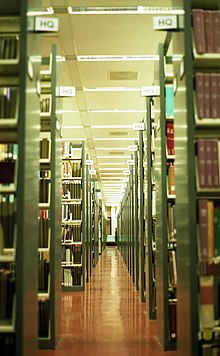
McHenry Library stacks
The McHenry Library houses UCSC's arts and letters collection, with most of the scientific reading at the newer Science and Engineering Library. The McHenry Library was designed by John Carl Warnecke.[46] In addition, the colleges host smaller libraries, which serve as quiet places to study. The McHenry Special Collections Library includes the archives of Robert A. Heinlein, the papers of Anaïs Nin, the papers and drawings of Beat poet Kenneth Patchen, the largest collection of Edward Weston photographs in the country, the mycology book collection of composer John Cage, a large collection of works by Satyajit Ray, the Hayden White collection of 16th-century Italian printing, a photography collection with nearly half a million items, and the Mary Lea Shane Archive. The latter contains an extensive collection of photographs, letters, and other documents related to Lick Observatory dating back to 1870.[81]
A 82,000-square-foot (7,600 m2) new addition to the library opened on March 31, 2008, including a "cyber study" room and a Global Village café. The original 144,000-square-foot (13,400 m2) library reopened on June 22, 2011 after seismic upgrades and other renovations.[82][83] In total, the University Libraries contain over 2.4 million volumes.
Grateful Dead archive
In 2008, UCSC agreed to house the Grateful Dead archives at the McHenry Library.[84][85] Exhibits of Grateful Dead Archive materials are on display in the Brittingham Family Foundation's Dead Central Gallery on the 2nd Floor of McHenry Library. The Dead Central exhibit space is open during all library business hours. UCSC plans to devote an entire room at the library, to be called "Dead Central," to display the collection and encourage research.[86] UCSC beat out petitions from Stanford and UC Berkeley to house the archives. Grateful Dead guitarist Bob Weir said that UCSC is "a seat of neo-Bohemian culture that we're a facet of. There could not have been a cozier place for this collection to land."[87] Silicon Valley entrepreneurs and Dead fans Roger McNamee and Bill Watkins are expected to join a committee to oversee and raise funds for the project.[88] The archive became open to the public July 29, 2012.
Student life
Most undergratuates are from California. The following tables show the ethnic and regional breakdown of the student body:
Regional Origin of 2015 Freshmen[89] | Percent |
Monterey Bay area and Santa Clara Valley | 11.8% |
San Francisco Bay Area | 26.2% |
Northern California | 1.5% |
| East Central California | 11.2% |
| Los Angeles-South Coast | 25.0% |
| San Diego and desert areas | 12.1% |
| Other U.S. states | 4.8% |
| Foreign | 7.2% |
| Unknown | 0.1% |
Ethnicity, Fall 2015[90] | Under- graduates |
White American | 33.0% |
Hispanic and Latino Americans | 31.2% |
Asian American | 21.0% |
| Two or More Races | 7.3% |
African American | 1.9% |
| International | 3.6% |
Native American | 0.1% |
| Pacific Islander or Native Hawaiian | 0.2% |
| Unknown | 1.6% |

Student Union
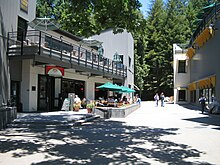
Quarry Plaza

KZSC lounge
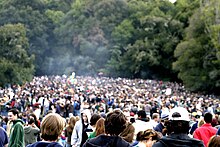
Students and others gather for a "420 Day" event in Porter Meadow at the University of California, Santa Cruz, campus on April 20, 2007.
UCSC students are known for political activism. In 2005, a Pentagon surveillance program deemed student opposition to military recruiters on campus a "credible threat," the only campus antiwar action to receive the designation.[91] In February 2006, Chancellor Denice Denton got the designation removed.[92] Military recruiters declined to return to UCSC the following year, but returned in 2008 to a more low-keyed student reception and protests using elements of guerrilla theatre, rather than vandalism or physical violence.[93][94] Thanks to students passing a $3 quarterly tuition increase to support buying renewable energy in 2006, UCSC is the sixth-largest buyer of renewable energy among college campuses nationwide.[95]
UC Santa Cruz is also well known for its cannabis culture. On April 20, 2007, approximately 2,000 UCSC students gathered at Porter Meadow to celebrate the annual "420". Students and others openly smoked marijuana while campus police stood by.[96] The once student-only event has grown since the city of Santa Cruz passed Measure K in 2006, an ordinance making marijuana use a low-priority crime for police. The 2007 event attracted a total of 5,000 participants. The university does not condone the gathering, but has taken steps to regulate the event and ensure security for all participants. On April 20, 2010, the school administration shut down the west entrance to campus and limited the number of buses that could drive through campus.[97][98]
Another well known tradition is what is known as "First Rain". Students run around campus naked or nearly naked to celebrate the school year's first night of heavy rain. The run begins at Porter and proceeds to travel through all the other colleges, collecting more students in its train.[99]
Student government
The Student Union Assembly was founded in 1985 to better coordinate bargaining positions between students and administration on campus-wide issues.[100] All the residential colleges and six ethnic and gender-based organizations send delegates to SUA.[101] There is a total of 138 recognized student groups as of 2008[update].[102]
Student media
All Student media organizations are funded by a student council referendum of $3.20 per student per quarter.[103]
City on a Hill Press, a weekly publication that serves as the traditional campus newspaper.
Fish Rap Live!, the alternative, comedic paper.
TWANAS, the Third World and Native American Student Press Collective publishes issues about every quarter for various communities of color at UCSC. Its peak years were during the 1970s, 1980s and 1990s.
Student Cable Television (SCTV) disbanded at the beginning of the 2010 academic school year. On The Spot (OTS), replaced the defunct SCTV organization, continuing the student-run television opportunities. On The Spot airs on channel 28 only on campus.[104]
The Moxie Production Group, which produces content on a quarterly basis.
The Project, a quarterly paper, for UCSC's radical community.
The Disorientation Guide, published on sporadic years, introduces new students to UCSC's radical history and various political issues that face the campus and community.[105]
Rapt Magazine, a quarterly literary and arts magazine.
Leviathan Jewish Journal, a Jewish student life publication.[106]- On The Spot, a student-run broadcast media organization, that produces a variety of shows including Press Center Live (Sketch-Comedy), ART (Music videos), and game shows.
Banana Slug News, a television broadcast news program.
Chinquapin, an open-ended creative journal sponsored by the creative writing department.[107]
Turnstile, a poetry journal.- "Gaia Magazine," a magazine about environmental and sustainability subjects that is published once a year.
Red Wheelbarrow, a "literary arts" journal.[108]
Matchbox Magazine, an annual humanities publication, started at UCSC, that operates across many UC campuses.[109]
EyeCandy, an annual student-run film journal associated with the Film and Digital Media department.[110]
KZSC, the student-run campus radio station.[111]
Santa Cruz Indymedia, a local activist resource with a lot of UCSC content.
The Film Production Coalition which produces films on a quarterly basis.[112]
Housing
Most of the UCSC undergraduate housing is affiliated with one of the ten residential colleges. The residence halls, which include both shared and private rooms, typically house fifteen to twenty students per floor and have common bathrooms and lounge areas. Some halls have coed floors where men and women share bathroom facilities, others have separate bathroom facilities for men and women. Single-gender, gender-neutral and substance-free floors are also available.
All of the colleges, except for Kresge, have both residence halls and apartments. Kresge is all apartments. Apartments are typically shared by four to eight students, have common living/dining rooms, kitchens and bathrooms, and a combination of shared and private bedrooms. Apartments at colleges other than Kresge are generally reserved for students above the freshman level.
In addition to the residential colleges, housing is available at the Village on the lower quarry, populated by continuing and transfer students (in 2016-17, this will be restricted to only continuing students); the Redwood Grove Apartments, which is available to continuing student applicants from all colleges; and the University Town Center, located downtown, that serves both continuing and transfer students. The Transfer Community is located in sections of both the A and B Buildings at Porter College and over 500 residents live within this theme housing. Graduate Student Housing is available near Science Hill, and UCSC also offers Family Student Housing units as well as a Camper Park for student-owned trailers and RVs.[113]
Greek life
UCSC is home to few fraternities and sororities. The first Greek organization on campus, Theta Chi, was given colony status on January 10, 1987 and chartered on October 14, 1989 (designation: Theta Iota). In the beginning, fraternities like Theta Chi and Sigma Alpha Epsilon were met with strong opposition from the student body. Student groups like P.A.C. (People's Alternative Community), S.A.G.E. (Students Against Greek Environments), and M.A.C. (Men's Alternative Community) protested the existence of Greek life at the UCSC campus.[114]
Greek life at UCSC includes fraternities Sigma Lambda Beta, Tau Kappa Epsilon, Sigma Pi, Lambda Phi Epsilon, Sigma Phi Zeta, Alpha Epsilon Pi, Pi Alpha Phi, and Delta Lambda Psi, the nation's first gender neutral queer Greek organization. Sororities that are members of the National Panhellenic Council at the University of California, Santa Cruz include Gamma Phi Beta and Kappa Kappa Gamma. Recently in June 2016 the Theta Xi chapter of Kappa Alpha Theta was chartered to bring a third National sorority to UC Santa Cruz.[115] Sororities on campus include Delta Sigma Theta, Sigma Lambda Gamma, Sigma Alpha Epsilon Pi, Alpha Kappa Delta Phi, Gamma Phi Beta, Kappa Kappa Gamma, Sigma Pi Alpha, Tri Chi, Sigma Omicron Pi, Kappa Zeta, Lambda Theta Alpha and Alpha Psi.[116] The most recent Greek lettered organization added to the campus was Zeta Phi Beta sorority, which chartered its chapter Gamma Phi as of Spring 2016.
Aside from social fraternities and sororities on campus, there are also a number of professional organizations as well. There are Kappa Gamma Delta,[117] a prehealth sorority, Sigma Mu Delta, a prehealth fraternity, Alpha Phi Omega, a coed service fraternity, Phi Alpha Delta, a pre-law fraternity, and Delta Sigma Pi, a co-ed professional business fraternity.[118]
Sustainability
Though UCSC has been known for its conservation efforts and environmentally minded students since it was founded, since 2000 enthusiasm for the UCSC sustainability movement has grown steadily among students and administrators alike. Students established the Student Environmental Center (SEC) in 2001, have held annual Earth Summits, and established a sustainability funding body, the Campus Sustainability Council. In 2004, the UC Policy on Sustainable Practices was released, stating that the University of California Office of the President was committed to minimizing its impact on the environment and reducing its dependence on non-renewable energy. This set the scene for huge breakthroughs in 2006, when a Committee on Sustainability and Stewardship (CSS) was established and a campus-wide Sustainability Assessment was completed. The following year, the pilot Sustainability Office was created to help institutionalize sustainability, coordinate communication and collaboration between the many entities already engaged in campus sustainability activities at UCSC, support policy implementation, and serve as a resource for the campus.[119] Sustainability has become a major part of every aspect of the campus, and students, staff, and faculty campus-wide are working toward sustainability in a variety of different ways.
Organizations
The following is a list of UCSC sustainability organizations, departments, gardens, and funding bodies on the UCSC campus:
- Alliance to Save Energy's Power Save Green Campus Program (formerly known as Green Campus Program)
- Arboretum
- California Student Sustainability Coalition (CSSC)
- Campus Sustainability Council (CSC)
- Campus Sustainability Office
- Carbon Fund
- Center for Agroecology & Sustainable Food Systems
- Center for Global, International and Regional Studies
- College Eight: Nurturing Green Entrepreneurs
- Community Agroecology Network (CAN)
- Education for Sustainable Living Program (ESLP)
- Environmental Studies Department
- Friends of the Community Agroecology Network (FoCAN)
- Friends of the Sustainability Office (FoSO)
- IDEASS
- Kresge Garden
- Kresge Natural Food Cooperative
- Meatless Mondays, Beefless Thursdays & Farm Fridays in the dining halls
- Path to a Greener Stevenson (PTAGS)
- Program in Community and Agroecology (PICA)
- Program Recognizing Offices Practicing Sustainability (PROPS), a green office certification program
- Site Stewardship Program
- Student Environmental Center (SEC)
- Student Environmental Center (SEC)
- Student Sustainability Advisers (SSA)
- UCSC Climate Change Research Resources
- UCSC Greenhouses
- UCSC Museum of Natural History Collections
- UCSC Natural Reserves
- UCSC Sustainability Engineering and Ecological Design
- Formula Slug
- Slugbotics
Athletics
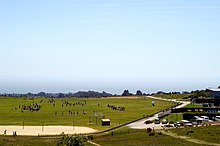
East Field
UCSC competes in Division III of the NCAA as an Independent member. There are fifteen varsity sports – men's and women's basketball, tennis, soccer, volleyball, swimming, cross country and diving, and women's golf. UCSC teams have been Division III nationally ranked in tennis, soccer, men's volleyball, and swimming. The Men's water polo team was ranked 18th in the nation in 2006 and won the D3 national Championship, however in 2009 the team was cut due to budget cuts. UCSC maintains a number of successful club teams. It has won multiple club national championships in men's tennis, 3 in men's waterpolo and also a women's Division II championship in club rugby.
In 2016, due to a mounting debt in funding of the athletic program, the university polled its students on whether or not they would approve an increase in tuition which would be necessary to maintain the athletic program. There was a significant doubt that the students would approve this increase. Contrary to the predictions, a majority of the students approved a significant addition to their annual tuition to maintain the existence of the athletic program.
Notable alumni and faculty
Notable alumni of the University of California, Santa Cruz include co-founder of the Black Panther Party Huey P. Newton (BA 1974, PhD 1980); actress and comedian Maya Rudolph (BA 1995); founder of Huffington Post and BuzzFeed Jonah Peretti (BA 1996); filmmaker Cary Fukunaga (BA 1999); and several Pulitzer Prize-winning journalists. Notable attendees include actor and comedian Andy Samberg and filmmaker Miranda July.
- Notable UC Santa Cruz alumni include:

Huey P. Newton, co-founder of the Black Panther Party
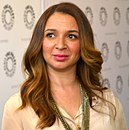
Maya Rudolph, actress and comedian

Jonah Peretti, founder of Huffington Post and BuzzFeed

Cary Fukunaga, film director, writer, and cinematographer

Reyna Grande, award-winning Mexican author
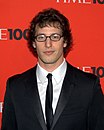
Andy Samberg, actor and comedian
See also
 University of California, Santa Cruz portal
University of California, Santa Cruz portal- Shakespeare Santa Cruz
- University of California, Santa Cruz, Arboretum
Notes and references
^ ab "And Now For Some Facts" (PDF). University of California, Santa Cruz. September 2015..mw-parser-output cite.citationfont-style:inherit.mw-parser-output .citation qquotes:"""""""'""'".mw-parser-output .citation .cs1-lock-free abackground:url("//upload.wikimedia.org/wikipedia/commons/thumb/6/65/Lock-green.svg/9px-Lock-green.svg.png")no-repeat;background-position:right .1em center.mw-parser-output .citation .cs1-lock-limited a,.mw-parser-output .citation .cs1-lock-registration abackground:url("//upload.wikimedia.org/wikipedia/commons/thumb/d/d6/Lock-gray-alt-2.svg/9px-Lock-gray-alt-2.svg.png")no-repeat;background-position:right .1em center.mw-parser-output .citation .cs1-lock-subscription abackground:url("//upload.wikimedia.org/wikipedia/commons/thumb/a/aa/Lock-red-alt-2.svg/9px-Lock-red-alt-2.svg.png")no-repeat;background-position:right .1em center.mw-parser-output .cs1-subscription,.mw-parser-output .cs1-registrationcolor:#555.mw-parser-output .cs1-subscription span,.mw-parser-output .cs1-registration spanborder-bottom:1px dotted;cursor:help.mw-parser-output .cs1-ws-icon abackground:url("//upload.wikimedia.org/wikipedia/commons/thumb/4/4c/Wikisource-logo.svg/12px-Wikisource-logo.svg.png")no-repeat;background-position:right .1em center.mw-parser-output code.cs1-codecolor:inherit;background:inherit;border:inherit;padding:inherit.mw-parser-output .cs1-hidden-errordisplay:none;font-size:100%.mw-parser-output .cs1-visible-errorfont-size:100%.mw-parser-output .cs1-maintdisplay:none;color:#33aa33;margin-left:0.3em.mw-parser-output .cs1-subscription,.mw-parser-output .cs1-registration,.mw-parser-output .cs1-formatfont-size:95%.mw-parser-output .cs1-kern-left,.mw-parser-output .cs1-kern-wl-leftpadding-left:0.2em.mw-parser-output .cs1-kern-right,.mw-parser-output .cs1-kern-wl-rightpadding-right:0.2em
^ As of June 30, 2017. "UC Annual Endowment Report FY17" (PDF). UC Santa Cruz Foundation. 2017. Archived from the original (PDF) on January 29, 2018. Retrieved April 11, 2018.
^ https://iraps.ucsc.edu/campus-information/common-data-set.html
^ https://iraps.ucsc.edu/campus-information/common-data-set.html
^ https://iraps.ucsc.edu/campus-information/common-data-set.html
^ "UC Financial Reports – Campus Facts in Brief" (PDF). University of California. Retrieved November 12, 2012.
^ "Colors – Communications & Marketing". Retrieved July 18, 2018.
^ "Banana Slug Mascot". Retrieved November 6, 2010.
^ Doyle, William T. (October 1, 2006). "What the city council has not told us about university expansion". Santa Cruz Sentinel. MediaNews Group. Retrieved February 19, 2010.
^ McHenry, Dean E. (1974). Spedding Calciano, Elizabeth, ed. Volume II The University of California, Santa Cruz: Its Origins, Architecture, Academic Planning and Early Faculty Appointments 1958–1968 (PDF). UC Santa Cruz. p. 59. Retrieved February 19, 2010.
^ "Long Range Development Plan, University of California Santa Cruz" (PDF). UC Santa Cruz Campus Planning Committee. October 21, 1963. Archived from the original (PDF) on June 24, 2010. Retrieved February 19, 2010.
^ "Santa Cruz: Historical Overview". University of California History Digital Archives. Regents of the University of California. June 18, 2004. Archived from the original on June 12, 2009. Retrieved February 19, 2010.
^ Stadtman, Verne A. (1967). "Santa Cruz". The Centennial Record of the University of California, 1868–1968. Regents of the University of California. pp. 503–504. Retrieved February 19, 2010.
^ Burchyns, Tony (June 25, 2006). "It's been 45 years since UCSC was founded – and Santa Cruz was irrecoverably changed". Santa Cruz Sentinel. MediaNews Group. Retrieved February 19, 2010.
^ ab Burns, Jim (March 17, 1998). "Dean E. McHenry, founding chancellor of UC Santa Cruz, dies at 87". Currents. University of California Santa Cruz. 2 (30). Retrieved February 19, 2010.
[permanent dead link]
^ Burchyns, Tony (July 2, 2006). "Unlike its nondescript past, UC Santa Cruz's future takes center stage". Santa Cruz Sentinel. MediaNews Group. Retrieved February 19, 2010.
^ Kerr, Clark (2001). The Gold and the Blue: A Personal Memoir of the University of California, 1949–1967 Volume I: Academic Triumphs. University of California Press. p. 261. ISBN 978-0-520-22367-7. OCLC 46240365. Retrieved February 19, 2010.
^ Seals, Brian (July 10, 2005). "35 years later, students' environmental report seems prescient". Santa Cruz Sentinel. Retrieved February 3, 2008.
^ Burchyns, Tony (July 9, 2006). "1980s ushered in discussion of UCSC expansion that continues today". Santa Cruz Sentinel. Retrieved February 2, 2008.
^ Honig, Tom (June 4, 2004). "Santa Cruz was once Reagan country". Santa Cruz Sentinel.
^ Marshall, Carolyn (January 27, 2007). "As College Grows, a City Is Asking, 'Who Will Pay?'". New York Times. Retrieved January 16, 2008.
^ Burchyns, Tony (July 16, 2006). "Tie-dyed philosophy majors of the past make way for pencil-protected science majors". Santa Cruz Sentinel. Retrieved February 2, 2008.
^ Bookwalter, Genevieve (August 9, 2008). "Suits over UCSC growth settled: City, county, neighbors reach deal; university agrees to concessions over roads, water and housing". Santa Cruz Sentinel. Archived from the original on August 15, 2008. Retrieved September 18, 2008.
^ Krieger, Lisa M. (September 30, 2007). "Think of UCSC as UC-Silicon Valley, new chancellor says". Mercury News. Retrieved October 28, 2007.
^ Mills, Kay (Spring 2001). "Changes at "Oxford on the Pacific," UC Santa Cruz turns to engineering and technology". National Crosstalk. National Center for Public Policy and Higher Education. 9 (2). Retrieved January 28, 2008.
^ Megha Satyanarayana (April 29, 2010). "UCSC cuts ribbon on $35 million digital arts building". San Jose Mercury News. Retrieved May 3, 2010.
^ "UC Santa Cruz to dedicate new Coastal Biology building on October 21". UC Santa Cruz News. Retrieved October 15, 2017.
^ "Parks and Recreation – Harvey West Park". Retrieved May 4, 2006.
^ "Parks and Recreation – Pogonip". Retrieved May 4, 2006.
^ "Henry Cowell Redwoods SP". Retrieved May 4, 2006.
^ "Wilder Ranch SP". Retrieved May 4, 2006.
^ Redfern, Cathy (September 2, 2001). "The original City on a Hill". Santa Cruz Sentinel. Retrieved February 5, 2008.
^ "UC Santa Cruz – University Family Student Housing". Archived from the original on October 26, 2006. Retrieved October 27, 2006.
^ Baine, Wallace (April 13, 2008). "'An Unnatural History of UCSC' traces the evolution of a magical campus setting – Santa Cruz Sentinel". Santa Cruz Sentinel. Archived from the original on April 13, 2008. Retrieved April 12, 2008.
^ "CAMPUS LIFE: California, Santa Cruz; Redwood Haven Inspires Battle Over an Elfland". New York Times. January 12, 1992. Retrieved April 12, 2008.
^ "UCSC Walking Map". Archived from the original on September 1, 2006. Retrieved March 15, 2011.
^ "Flickr: Oaks Path Night". Retrieved March 15, 2011.
^ Tovin Lapan, "UCSC attempts to stop students from climbing campus favorite 'Tree Nine' " Archived May 20, 2013, at the Wayback Machine ' 'Santa Cruz Sentinel' ' , October 3, 2010
^ "UCSC Campus Field Trip". Web.archive.org. April 17, 2001. Archived from the original on April 17, 2001. Retrieved November 15, 2017.CS1 maint: BOT: original-url status unknown (link)
^ "Empire Cave". Web.archive.org. April 20, 2001. Archived from the original on April 20, 2001. Retrieved November 15, 2017.CS1 maint: BOT: original-url status unknown (link)
^ "UC Santa Cruz – Academic Programs". Retrieved May 27, 2009.
^ "University of California, Santa Cruz (Statistics)". The Princeton Review. Retrieved June 29, 2006. (Note: Registration required)
^ "3 Plus 3". 3plus3.ucsc.edu. Retrieved November 15, 2017.
^ "Rankings by total R&D expenditures". National Science Foundation. Archived from the original on June 12, 2018. Retrieved August 17, 2014.
^ Jarrell, Randall (1997). "Kenneth V. Thimann: Early UCSC History and the Founding of Crown College" (PDF). Regional History Project. University of California, Santa Cruz. pp. 11–34. Archived from the original (PDF) on July 14, 2006. Retrieved May 14, 2009.
^ ab Jarell, Randall (1993). "Donald T. Clark: Early UCSC History and the Founding of the University Library". Regional History Project. University of California, Santa Cruz. pp. 76–81. Retrieved May 14, 2009.
^ Calciano, Elizabeth Spelding (1974). "Dean E. McHenry: Founding Chancellor of the University of California, Santa Cruz, Volume II: The University of California, Santa Cruz: Its Origins, Architecture, Academic Planning, and Early Faculty Appointments, 1958–1968". Regional History Project. University of California, Santa Cruz. pp. 298–305. Retrieved October 31, 2013.
^
Ragan, Tom (July 31, 2005). "Country's oldest organic school hails from UC Santa Cruz". Santa Cruz Sentinel. Retrieved February 8, 2008.
^ Kreiger, Kathy (October 10, 2002). "Apprentices spread UC farm techniques far and wide". Santa Cruz Sentinel. Retrieved February 8, 2008.
^ "Center for Biomolecular Science and Engineering". Santa Cruz: University of California. Retrieved February 20, 2010.
^ Abate, Tom (August 7, 2000). "UC Santa Cruz Puts Human Genome Online, Programming wizard does job in 4 weeks". San Francisco Chronicle. Retrieved February 4, 2008.
^ Wade, Nickolas (February 13, 2001). "Reading the book of life; Grad Student Becomes Gene Effort's Unlikely Hero". New York Times. Retrieved April 15, 2008.
^ "UCSC Genome Browser". Santa Cruz: University of California. Retrieved February 20, 2010.
^ "Center for Adaptive Optics". Santa Cruz: University of California. Retrieved February 20, 2010.
^ "UARC". Archived from the original on May 3, 2007. Retrieved November 25, 2016.
^ "Academic Ranking of World Universities 2018: USA". Shanghai Ranking Consultancy. Retrieved November 19, 2018.
^ "America's Top Colleges 2018". Forbes. Retrieved November 19, 2018.
^ "Best Colleges 2019: National Universities Rankings". U.S. News & World Report. November 19, 2018.
^ "2018 Rankings - National Universities". Washington Monthly. Retrieved November 19, 2018.
^ "Academic Ranking of World Universities 2018". Shanghai Ranking Consultancy. 2018. Retrieved November 19, 2018.
^ "QS World University Rankings® 2018". Quacquarelli Symonds Limited. 2017. Retrieved November 19, 2018.
^ "World University Rankings 2019". THE Education Ltd. Retrieved November 19, 2018.
^ "Best Global Universities Rankings: 2019". U.S. News & World Report LP. Retrieved November 19, 2018.
^ "University of California--Santa Cruz - U.S. News Best Grad School Rankings". U.S. News & World Report. Retrieved 4 June 2017.
^ "University of California--Santa Cruz - U.S. News Best Global University Rankings". U.S. News & World Report. Retrieved 3 November 2018.
^ "University of California--Santa Cruz". U.S. News & World Report.
^ "Kiplinger's Best Values in Public Colleges - 2017". Kiplinger's Personal Finance. December 2016.
^ "MONEY's Best Colleges". Money. 2016.
^ "Economics web site ranks UCSC sixth in the world for research on international finance". Archived from the original on May 28, 2010. Retrieved November 12, 2009.
^ "UCSC ranked 1st in High Times 2007". Archived from the original on September 20, 2008. Retrieved October 14, 2008.
^ "UCSC ranked in top 50 for Game Design". Retrieved November 5, 2010.
^ "Top Graduate Schools for Video Game Design 2011".
^ Franek, Robert. The Best 376 Colleges, 2012 Edition. The Princeton Review. Print.
^ abcdef
"UCSC General Catalog 2004–2006 (The Colleges section)". Archived from the original on June 27, 2006. Retrieved June 29, 2006.
^ "Multi-year Fall Frosh and Transfer Application Summaries: Fall 2005-2016 Frosh". UC Santa Cruz Institutional Research, Assessment & Policy Studies. Retrieved December 13, 2016.
^ "Common Data Sets, Part C". University of California, Santa Cruz.
^ "Common Data Set 2015-16, Part C". University of California, Santa Cruz. Missing or empty|url=(help);|access-date=requires|url=(help)
^ "UC Santa Cruz Facts". admissions.ucsc.edu. Archived from the original on December 12, 2017. Retrieved July 31, 2018.
^
Schevitz, Tanya (February 24, 2000). "UC Santa Cruz To Start Using Letter Grades". San Francisco Chronicle. Retrieved February 2, 2008.
^ "UCSC Discover – Academics". Archived from the original on June 19, 2006. Retrieved June 29, 2006.
^ "UCSC Special Collections—Introduction". Retrieved May 4, 2006.
^ "A library for the 21st century: McHenry turns a page". Archived from the original on January 29, 2009. Retrieved September 27, 2008.
^ Brown, J.M. (April 25, 2008). "UCSC's McHenry Library gets a facelift steeped in 'green' design principles". Santa Cruz Sentinel. Archived from the original on February 8, 2009. Retrieved April 25, 2008.
^ McKinley, Jesse (April 24, 2008). "A Deadhead's Dream for a Campus Archive". New York Times. Retrieved April 24, 2008.
^ McMahon, Regan (April 24, 2008). "Grateful Dead archives going to UC Santa Cruz". San Francisco Chronicle. Retrieved April 24, 2008.
^ Brown, J.M. (April 24, 2008). "Slugs and Roses: Grateful Dead to donate memorabilia to UC Santa Cruz archives". Santa Cruz Sentinel. Archived from the original on May 7, 2008. Retrieved April 24, 2008.
^ Brown, J.M. (April 25, 2008). "Grateful Dead says UC Santa Cruz proposed sweetest deal to store archives". Santa Cruz Sentinel. Archived from the original on April 28, 2008. Retrieved April 25, 2008.
^ Clark, Don (April 24, 2008). "California University Gets 'Grateful Dead' Archive". Wall Street Journal. Retrieved April 25, 2008.
^ "Regional Origin of New Frosh and Transfers 2015 Fall Quarter" (PDF). UCSC Office of Institutional Research, Assessment and Policy Studies. December 4, 2015.
^ "Undergraduate and Graduate Students by Ethnicity and Class Level 2014 Fall Quarter" (PDF). UCSC Office of Institutional Research, Assessment and Policy Studies. December 4, 2015.
^ Kershaw, Sarah (January 14, 2006). "A Protest, a Spy Program and a Campus in an Uproar". New York Times. Retrieved January 28, 2008.
^ Seals, Brian; Dunlap, Tom (February 11, 2006). "Pentagon removes UCSC from 'credible threat' list". Santa Cruz Sentinel. Retrieved February 3, 2008.
^ Sideman, Roger (April 20, 2007). "Military recruiters back out of UC Santa Cruz job fair". Santa Cruz Sentinel. Retrieved April 27, 2008.
^ Brown, J.M. (April 23, 2008). "Anti-war students disrupt career fair at UC Santa Cruz, but military recruiters stick around – Santa Cruz Sentinel". Santa Cruz Sentinel. Archived from the original on May 22, 2008. Retrieved April 23, 2008.
^ Brown, J.M. (May 6, 2008). "UCSC sixth-best college for green power". Santa Cruz Sentinel. Archived from the original on May 7, 2008. Retrieved May 14, 2008.
^ King, Matt (April 24, 2007). "Thousands at UCSC burn one to mark pot holiday". Santa Cruz Sentinel. Retrieved October 18, 2013.
^ Brown, J.M. (April 18, 2008). "UCSC takes security measures for '4/20". Santa Cruz Sentinel. Archived from the original on November 20, 2008. Retrieved April 18, 2008.
^ Ragan, Tom (April 22, 2008). "Police: Pot-smoking event in UCSC meadow 'a moral slap in the face". Santa Cruz Sentinel. Archived from the original on February 8, 2009. Retrieved April 23, 2008.
^ Moersen, Scott (October 12, 2006). "A Naked Run Through Campus". City on a Hill Press. Retrieved April 27, 2008.
^ "Student Union Assembly". UC Santa Cruz. Retrieved April 2, 2008.
^
"Student Union Assembly, Orgs". UC Santa Cruz. Archived from the original on April 5, 2009. Retrieved April 2, 2008.
^ "SOAR". soar.ucsc.edu. Retrieved April 2, 2008.
^ Jondi, Gumz (May 29, 2005). "UC Santa Cruz students voice their desires through fee vote". Santa Cruz Sentinel. Retrieved April 2, 2008.
^ Blumenfield, Zoe (March 18, 2007). "SCTV looks to the future: Students say lights, camera, action". scsextra.com. Retrieved April 12, 2008.
^ Sideman, Roger (October 8, 2006). "UCSC students aim to 'disorient' one another". Santa Cruz Sentinel. Retrieved April 12, 2008.
^ "Leviathan Jewish Journal – Leviathan Jewish Journal at UC Santa Cruz". Leviathanjewishjournal.com. 2016-07-19. Retrieved 2016-09-27.
^ "Chinquapin". Santa Cruz: University of California. Archived from the original on March 20, 2003. Retrieved February 20, 2010.
^ "Creative Writing Program Publications". Santa Cruz: University of California. Retrieved February 20, 2010.
^ "Matchbox Magazine". Santa Cruz: University of California. Archived from the original on February 21, 2010. Retrieved February 20, 2010.
^ "Eyecandy". Eyecandy.ucsc.edu. Retrieved 2016-09-27.
^ Sideman, Roger (June 26, 2006). "KZSC Radio turns up the juice — more powerful transmitter being installed". Santa Cruz Sentinel. Retrieved April 12, 2008.
^ "The Film Production Coalition". Santa Cruz: University of California. Archived from the original on August 28, 2008. Retrieved February 20, 2010.
^ "Student Housing Services". Archived from the original on April 4, 2008. Retrieved April 16, 2008.
^ "Wayback Machine". Web.archive.org. August 31, 2011. Archived from the original on August 31, 2011. Retrieved November 15, 2017.
^ "Kappa Alpha Theta - What's New - Kappa Alpha Theta Welcomes UC Santa Cruz!". Kappaalphatheta.org. Retrieved 2016-06-14.
^ "List of Greek Organizations". soar.ucsc.edu. Retrieved 2016-06-14.
^ "Kappa Gamma Delta- UC Santa Cruz, Zeta Chapter". KGD. Retrieved November 15, 2017.
^ "UCSC Discover - Student Life". Web.archive.org. May 31, 2010. Archived from the original on May 31, 2010. Retrieved November 15, 2017.CS1 maint: BOT: original-url status unknown (link)
^ "History of the Sustainability Office". Sustainability Office. UCSC Sustainability Office. Archived from the original on June 7, 2012. Retrieved May 21, 2012.
External links
| Wikimedia Commons has media related to University of California, Santa Cruz. |
Official website
- UC Santa Cruz Athletics website
Coordinates: 37°00′N 122°04′W / 37.00°N 122.06°W / 37.00; -122.06
